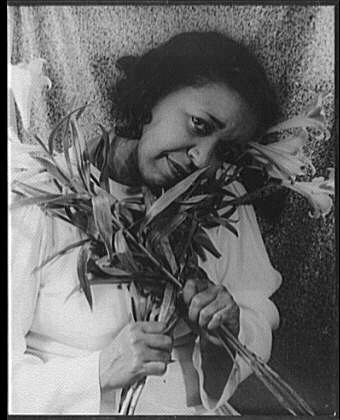Louis Jordan is another of the key figures
in the development of rock and roll and R&B. He was a talented and colorful
figure who was a saxophonist, songwriter, and bandleader. He has been credited
with creating a style of music called “jump blues” which is the direct
forerunner of R&B, the music which would later morph into rock and roll.
A celebration of the best popular music of the 20th century
Showing posts with label jazz singer. Show all posts
Showing posts with label jazz singer. Show all posts
Thursday, October 17, 2019
Louis Jordan and His Tympany Five
Thursday, June 6, 2019
Frank Sinatra: In the Wee Small Hours
Prior to the meteoric rise
of Elvis Presley and rock and roll, Frank Sinatra was the biggest male singing
phenomenon that popular music had ever seen. Sinatra’s rise to prominence was
accompanied by the same female hysteria that would be heard with the rise of
Presley and The Beatles in later decades.
Sinatra was born in Hoboken , New Jersey
By the time Sinatra left the Dorsey
Orchestra, he was already a pop star and was ready to move on to recordings and
performances with himself getting top billing. Sinatra continued to record
scads of hit songs throughout the mid-late Forties and early Fifties and branch
out as an entertainer by acting in movies. He eventually formed the infamous
“rat pack” with show business cronies, Sammy Davis Jr. and Dean Martin.
By the mid-Fifties, when rock and roll was
beginning to replace swing and vocal jazz as America’s new pop music, Sinatra
openly railed against the new music for being primitive and crude causing Elvis
Presley to publically express his dismay at the comments.
Sinatra would begin to record his own
albums in 1945, with his first notable effort being “The Voice of Frank
Sinatra” (1946) on Columbia Records with The Nelson Riddle Orchestra. Several
albums would follow, and then in 1954, Sinatra would record his first
classic album, “Songs for Young Lovers” The
following year Sinatra would record the album that is generally cited as his
masterpiece, “In the Wee Small Hours” in which Sinatra delivers sixteen songs
of heartbreak in inimitable style.
Numerous other essential albums would
follow for the next twenty years with the best being, “Songs for Swingin’ Lovers!”
(1956), “A Swingin’ Affair” (1957), “Frank Sinatra Sings for Only the Lonely”
(1958), “September of My Years” (1965), and “Sinatra at the Sands” (1966).
 |
| Sinatra on the town |
Ethel Waters: Sweet Man Blues
Ethel Waters was one of the most popular
African-American singers and actresses of the Twenties. She was born in Chester , Pennsylvania
Waters moved to New York
Waters appeared in a number of musical
productions and films during the Twenties including, “Check and Double Check,”
featuring Amos and Andy and Duke Ellington. By the end of the Thirties, she was
a big star on Broadway.
In 1949, Waters received an Oscar
nomination for best supporting actress for the film, “Pinky.” Waters died in
1977. A series of compilations called, “The Chronological Classics” are the
best sources of her classic recordings.
 |
| Ethel Waters in 1940 |
Billie Holiday: Lady Day
Billie Holiday’s life is the stuff of jazz
legend. She rose from poverty and abuse to become one of the biggest stars of
jazz during the Thirties and Forties. Holiday
was a great singer who did not possess a great voice. She employed her voice like
a horn player would his horn, and had a reputation for taking mediocre songs
and transforming them into greatness. Her singing style was influenced by
Bessie Smith’s singing and Louis Armstrong’s trumpet playing. Fellow jazz musicians
referred to her as simply, “Lady Day.”
Holiday was born in Baltimore , Maryland Hammond
Despite being offered only mediocre
material to record, she was supported by some of the finest musicians in jazz,
including pianist Teddy Wilson and saxophonist, Lester Young, who would coin
her “Lady Day” and become her closest friend and musical collaborator.
In 1937, Holiday
toured with the Count Basie Orchestra and later joined Artie Shaw’s Orchestra.
She stayed with Columbia Records until 1942, only leaving once for the
Commodore label with which she recorded the classic and searing song about
lynching, “Strange Fruit.” In 1942, she signed with Decca records and later
ended up recording for Verve. One of her last sessions with Columbia
In the late Forties,Holiday
was convicted of heroin possession and spent several months in prison. Due to
the conviction, she was unable to obtain a cabaret card, making it impossible
for her to find work in New York City New York
In the late Forties,
Holiday’s best recordings can be found on
the following collections: “Lady Sings the Blues” (1956), “Songs for Distingue
Lovers” (1958), “Lady in Satin” (1958), “The Billie Holiday Story” (1959), “The
Golden Years” (1962), “Billie Holiday’s Greatest Hits” (1967), “Lady Day: The
Complete Billie Holiday on Columbia (1933-1944)” (2001), “Lady Day: The Best of
Billie Holiday” (2001), “The Ultimate Collection” (2005), and “Lady Day: The
Master Takes and Singles” (2007).
 |
| Lady Day |
Subscribe to:
Comments (Atom)
Mary Lou Williams: Night Life
Mary Lou Williams is probably the most important female African-American jazz pianist. Williams was also a fine songwriter and arran...

-
Fletcher Henderson was a jazz pianist and bandleader born in Cuthbert , Georgia , in 1897. Henderson was the leader of one of the best Afr...
-
The Beatles are almost universally regarded as the greatest act in the history of post-war popular music, and that claim is hard to deny w...
-
Saxophonist Charlie Parker is considered by many to be the best musician in the history of jazz. He is one of the few jazz musicians who cou...

